Original URL: https://www.theregister.com/2013/07/02/review_apple_time_capsule_2013/
Apple Time Capsule 2013: Next-gen wireless networking, anyone?
802.11ac comes to Cupertino’s NAS-cum-Wi-Fi router
Posted in Personal Tech, 2nd July 2013 08:58 GMT
Review The new versions of Apple’s AirPort Extreme and Time Capsule Wi-Fi kit went almost unnoticed during Apple’s WWDC keynote speech earlier this month, overshadowed by the anti-skeuomorphic hoo-ha surrounding iOS 7 and the introduction of the first MacBook Air models equipped with Intel’s new Haswell processors.
But the AirPort Extreme and Time Capsule are next-generation products too, and are worthy of attention by virtue of introducing next-generation 802.11ac Wi-Fi to Cupertino’s product range.
Apple isn’t the first manufacturer to adopt 802.11ac for its networking products, of course, but it is one of the very first to integrate 802.11ac into its computers, in the form of the aforementioned MacBook Air. That finally gives us the opportunity to see this so-called “5G Wi-Fi” - as Broadcom, supplier of Apple’s 802.11ac chips, calls it - in action without all that tedious messing about with USB dongles.
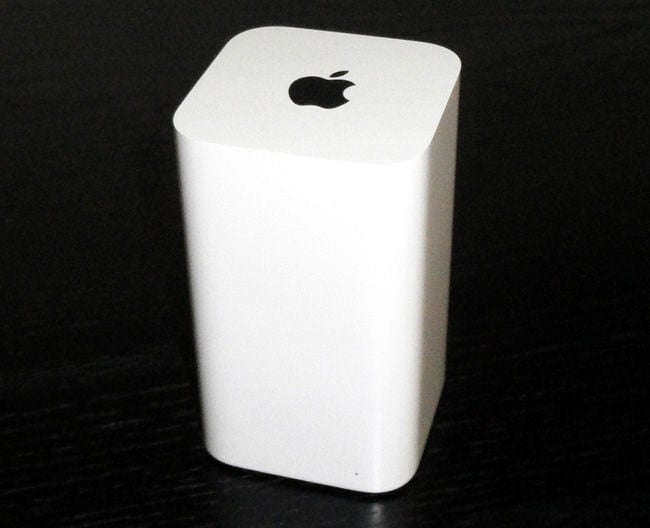
Apple’s Time Capsule, now oriented vertically
The two new AirPort devices are identical, sporting a new design that is taller and thinner than previous generations, and with the only significant difference being the internal hard drive that allows the Time Capsule to act as a NAS drive.
Like the diminutive AirPort Express – which remains 802.11n only – both devices measure just 97.5mm wide and deep. However, the pristine white plastic case has been extruded upwards to the towering height of 165mm – providing, according to Apple, better signal dispersal for the 3 x 3 array of six separate antennas that is housed right at the top of the unit.
I wasn’t allowed to take my Time Capsule apart, but reports from teardown merchant iFixit suggest that this new design is – unusually for Apple these days – fairly amenable to DIY repairs. The base of the unit can be levered off without too much trouble, with the internal hard drive apparently being quite easy to replace or upgrade – though you can say goodbye to your warranty should you do so, of course.
Incidentally, iFixit also reports that the AirPort Extreme can’t have an HDD shoved up its rear end in order to convert it into a Time Capsule, as its compact motherboard lacks a suitable connector.
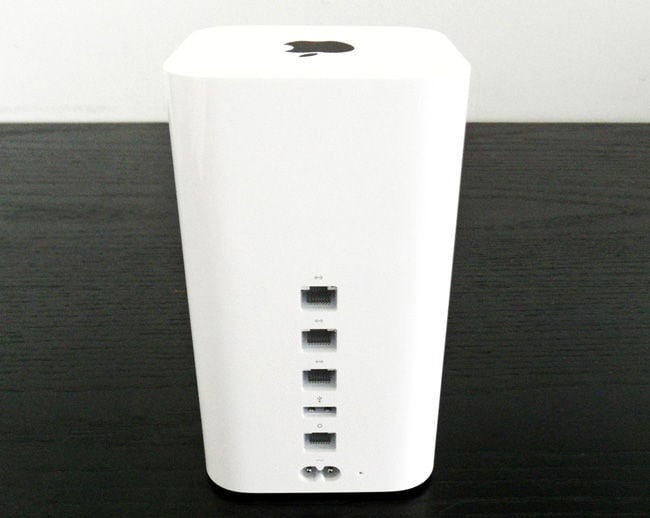
Standard router port array
Tucked around the back of the unit you’ll find the Time Capsule’s normal complement of ports: three Gigabit Ethernet jacks for client computers and networking gear; a USB 2.0 port for connecting a printer or additional storage device; a fourth Ethernet port for your Internet connection; and the figure-of-eight power socket. The AC transformer is built in, as before. As always, the Time Capsule and AirPort Extreme lack an ADSL or cable modem, so they’ll have to be connected to an existing modem if you want to connect to the internet.
Like its 802.11n-supporting predecessor, the 2013 Time Capsule can broadcast simultaneously on both the 2.4GHz and 5GHz frequencies. However, 802.11ac only operates on 5GHz – leaving the 2.4GHz frequency to 802.11n – where it doubles the standard channel width from 40MHz to 80MHz. It also includes an option called beamforming – a kind of triangulation technique that utilises the antenna array to analyse the location of connected 802.11ac devices and to boost the signal strength along the best possible path.
Both the 80MHz channel width and beamforming features of 802.11ac appear to be automatically enabled on the Time Capsule. If the Capsule and client can use them, they will - there are no obvious switches to enable or disable these modes.
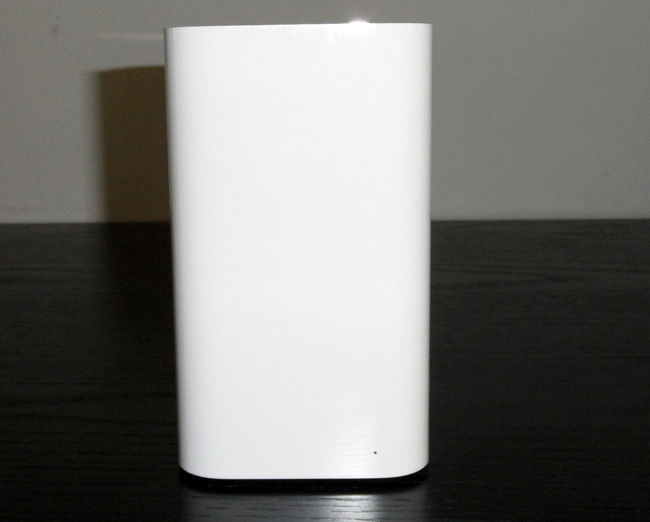
Pale face
Fortunately, I was able to get my hands on one of the new MacBook Air models to test with the new Time Capsule. Having just a single 802.11ac MacBook Air meant that I wasn’t able to test raw Wi-Fi throughput by transferring files directly between two machines, but the Time Capsule is primarily intended for use as a network back-up device so I put it through its paces by backing-up my 15GB iTunes library containing a mixture of both small audio and large video files.
Straightforward set-up
The initial set-up process was very straightforward, thanks to Apple’s AirPort Utility, which provides typical Mac ease-of-use. It detected my Time Capsule automatically and then provided simple options for setting up a new network or using it to extend my existing network. There are also options for setting up a guest network to run alongside the main WLAN, and a to host a separate network on the 5GHz channel – which I used in order to run my back-up tests.
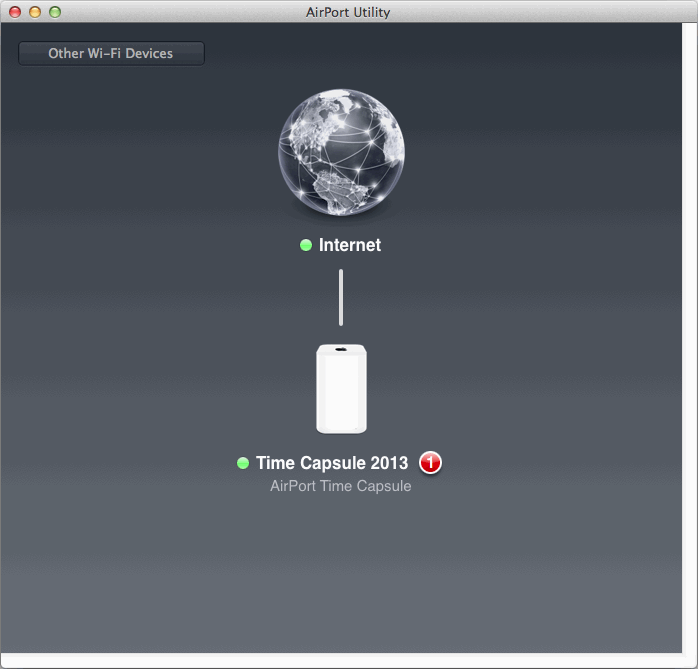
Apple’s Airport Utility
Needless to say, there’s a version of the AirPort Utility available for iOS devices, for Macs and also for Windows. There’s no HTML-based UI for folk using other platforms, and the Windows version is a generation behind the Mac – currently 5.6 on Windows, compared to 6.3 for the Mac. The Windows version lacks the graphical interface of the Mac version, which is no real loss, but the Windows version is also rather dumb. It wasn’t able to detect my Time Capsule unless the Time Capsule was connected to the internet, which means that you’ll struggle if you simply want to set up a self-contained wireless network at home or in your office.
Apple’s website promises “up to 3x faster Wi-Fi” for 802.11ac, so to test the performance of the new Time Capsule I copied my iTunes library onto it using 802.11n on my old office iMac - using first the 2.4GHz and then the 5GHz frequencies - and then repeated that test using the new MacBook Air with 802.11ac running at 5GHz. I also performed each test twice, initially at a distance of just 1m, and then with the Macs in another room about 10m away.
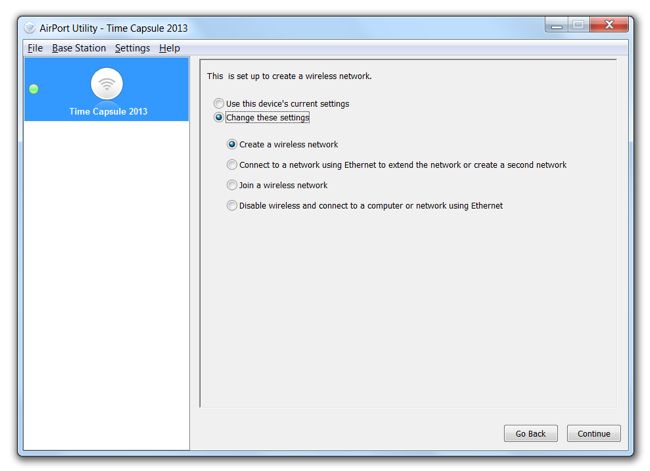
The Windows version of Airport Utility is behind the times
Performance using 802.11n was fairly modest, hitting just 66.67Mbps on 2.4GHz from 1m, and dipping to 59.70Mbps from 10m. Switching up to 5GHz improved performance slightly, boosting the speed to 83.33Mbps at 1m and 81.63Mbps at 10m. However, back-ups performed using 802.11ac on the MacBook Air romped ahead, roughly doubling performance with speeds of 170.21Mbps at 1m and 158.10Mbps at 10m.
I also copied my iTunes library back onto each Mac from the Time Capsule. The speeds for 802.11n on the iMac remained pretty much the same when doing this, but 802.11ac on the MacBook Air ran even faster, hitting 210Mbps at 1m and 200Mbps at 10m. That’s not “3x faster”, but it’ll still be a welcome improvement for Mac users who want to use the Time Capsule for their Time Machine back-ups.
Data Transfer Test Results
Write Speeds
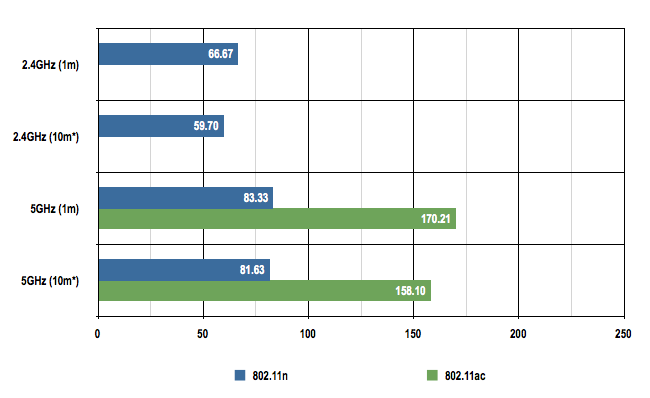
Data transfer rates in Megabits per Second (Mbps)
Longer bars are better
Bear in mind, these are comparisons made with a specific application. 802.11ac’s maximum radio data rates are faster than these numbers, which are lower because of copy mechanism and disk overheads. The picture the figures give, then, is not absolute speed but relative to the previous generation of Wi-Fi. The Air’s Wi-Fi card has two antennas - other machines may have three or four, and this will result in higher speeds still.
Option-clicking the Wi-Fi icon in Mac OS X populates the menu with extra wireless connection information. On the Air, it reported a peak Transmit Rate of 867Mbps. In comparison, the iMac reported 130Mbps, as did a previous-but-one generation of MacBook Air.
Data Transfer Test Results
Read Speeds
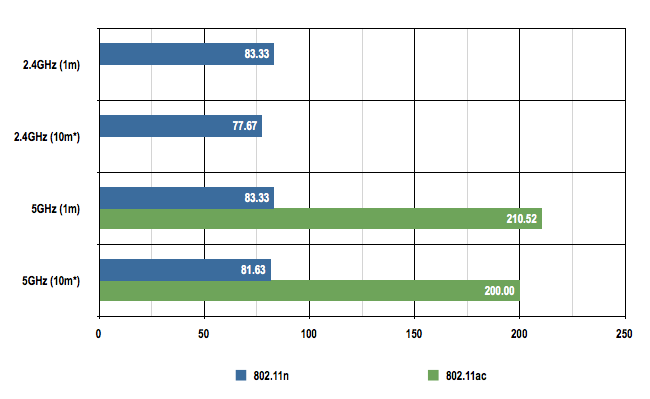
Data transfer rates in Megabits per Second (Mbps)
Longer bars are better
And, by Apple standards, the prices aren’t that bad either. The basic AirPort Extreme costs £169 which is in line with comparable 802.11ac routers at the moment. The 2TB version of the Time Capsule is also reasonable enough - it’s £249 - given that it combines shareable network storage with an 802.11ac base-station. However, the 3TB Time Capsule seems overpriced, jumping up to £349 for just one extra terabyte. You also have to take into account the lack of an ADSL or cable modem, which means that neither the AirPort Extreme nor the Time Capsule provides the all-in-one networking hub that many people might prefer.
The Reg Verdict
The scarcity of PCs and Macs that support 802.11ac right now means that the Time Capsule is hardly a must-have item, even for devout Apple fanbois. However, the 802.11ac tech does provide a significant improvement in performance when compared to 802.11n, and the Time Capsule’s ease of use makes it a good choice for Mac users who are in the market for a new NAS drive or a Wi-Fi upgrade. ®